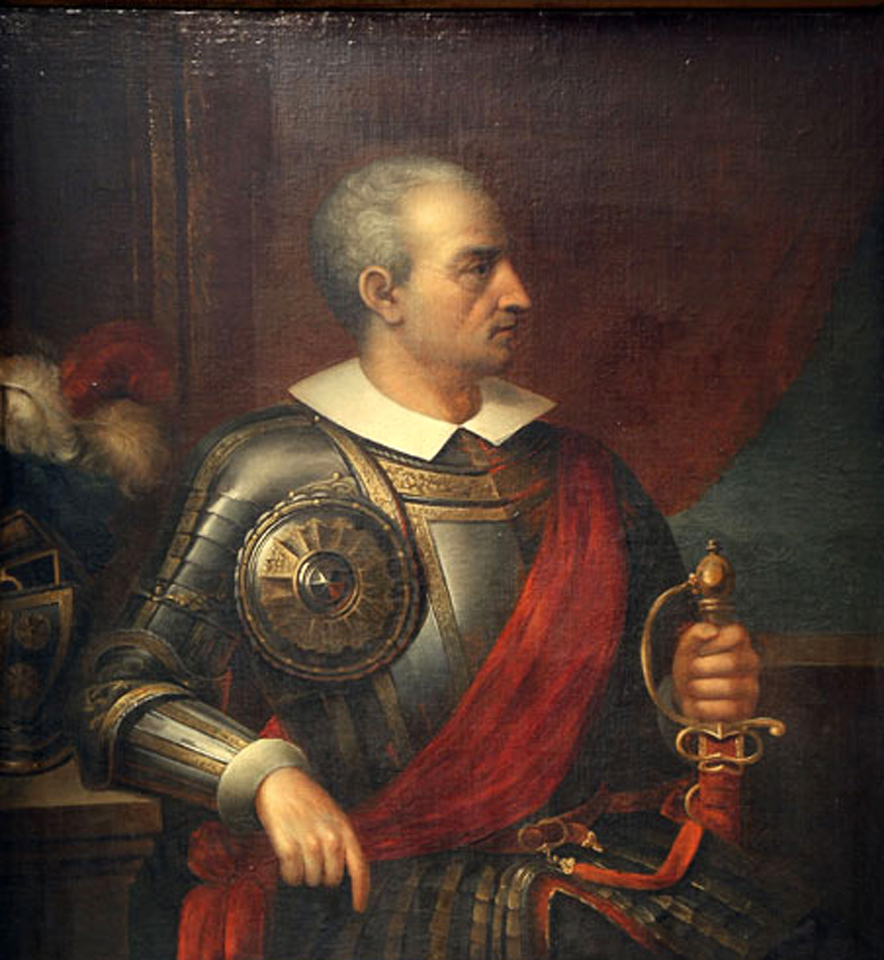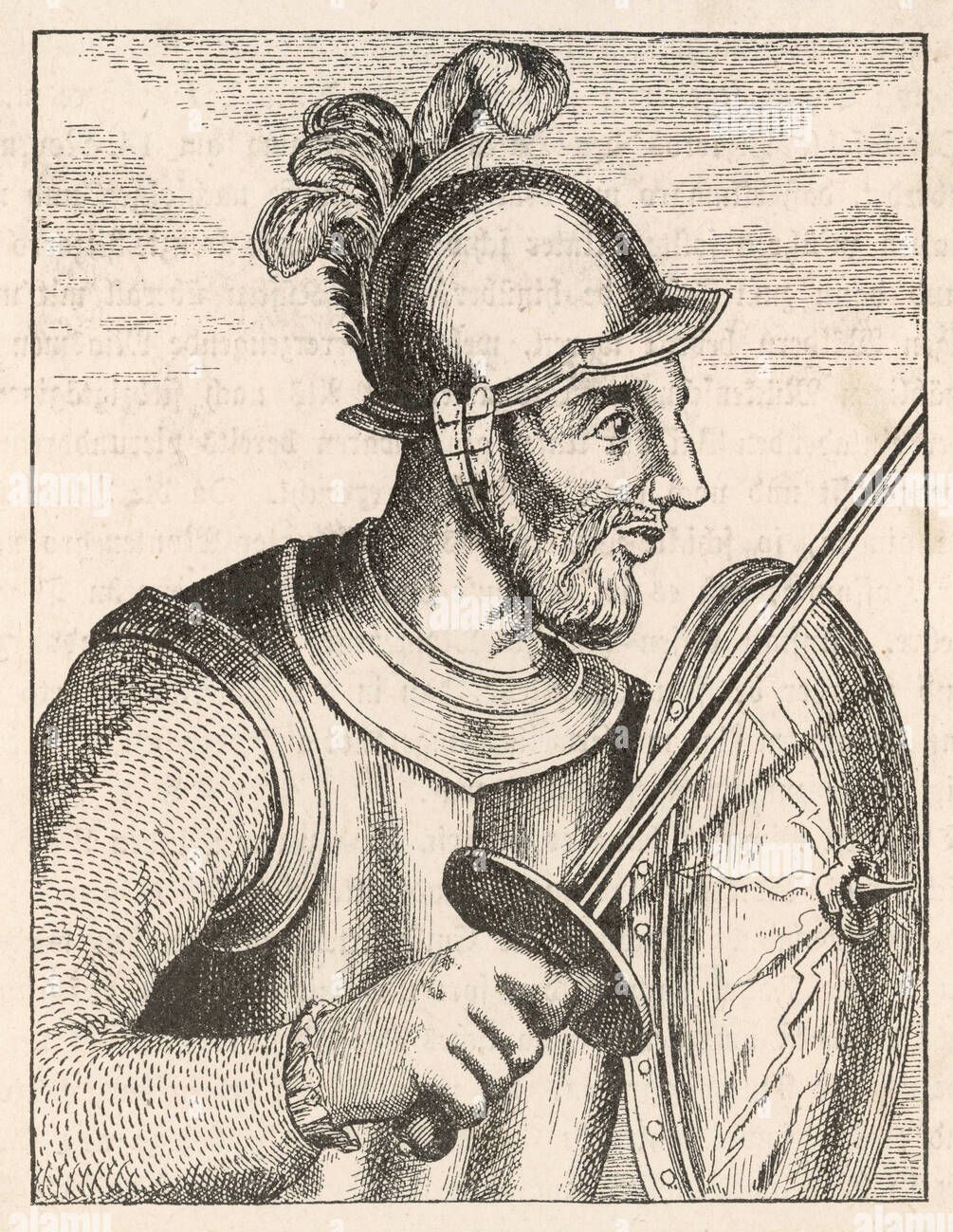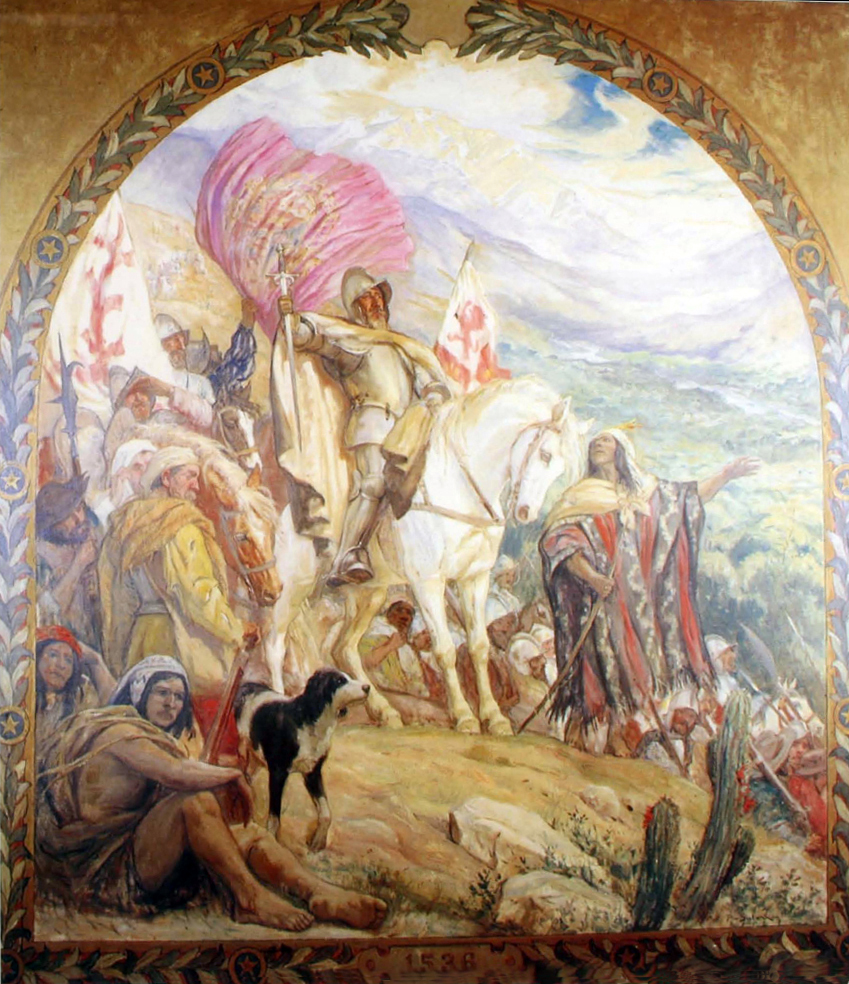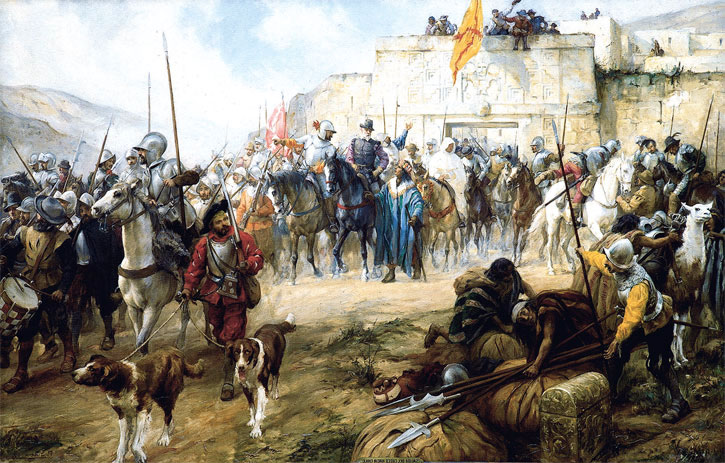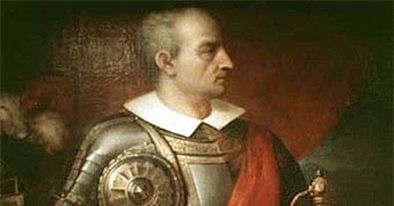
Diego de Almagro Biography
Summary
Diego de Almagro was a conquistador, adelantado, governor and discoverer of Chile. He was born in 1480 in the province of Ciudad Real (Castile), it is disputed whether in the town of Almagro or Malagón. His real name was Diego de Montenegro Gutiérrez, the illegitimate son of an extramarital affair, so his mother, in order to avoid dishonour, gave him to an institution in a nearby town.
His childhood was quite eventful, his rebellious and nervous character made him not want to be under anyone’s discipline, not even that of his relatives, and he settled in Seville where, in those years, juicy news of the discoveries of Spanish navigators beyond the Ocean was arriving. This led him to enlist in Pedrarias Dávila’s expedition of 1514, which would set out for the Tierra Firme, recently colonised with the founding of Santa María la Antigua del Darién.
Once in the Darién, he took part in various expeditions with Vasco Núñez de Balboa and Francisco Pizarro, obtaining a plot of land in the recently founded city of Acla and Indians who were given to him to work his lands. This allowed him to achieve a certain amount of wealth that enabled him to take on greater ventures. In Panama he had a son with a local Indian named Ana Martínez, whom he named Diego, who later became known as Diego de Almagro, el Mozo.
He partnered with Pizarro and the vicar of the Darien, Hernando de Luque, in an exploration venture south of Panama in search of lands called Piru. A pair of expeditions led by Gaspar de Morales and Pascual de Andagoya had recently returned from those lands, bringing news of great towns and riches.
In this way he took part in the conquests of Peru. On one of his journeys, in 1525, Almagro lost an eye fighting against the natives, which is why he became known as “the one-eyed man”. Once the Inca empire had been defeated, he took part, together with Sebastián de Belalcázar, in the conquest of Quito, which opened the way to the conquest of the kingdom of New Granada. There in Quito, news was received of the arrival of a military expedition led by Pedro de Alvarado, governor of Guatemala, who intended to occupy that territory. Pizarro sent Almagro to meet him and convince him that those territories were no longer free, and made him an offer which he accepted by buying part of his army. Almagro had managed to avoid a confrontation between Spaniards.
After his Peruvian adventure, the king appointed him governor of the kingdom of Nueva Toledo, a still unexplored territory called Chile, which lay to the south of Pizarro’s Nueva Castilla. To this end, in 1535 he organised and executed an extremely tough expedition that led him to march south through Upper Peru, cross the Andes and reach the valley of the Copiapó River in Chile. There he saw that the riches of Peru were non-existent and that only agricultural exploitation could extract something from the land. His men pressured him not to stay there and to return to Peru to take possession of the city of Cuzco, claiming that the Inca capital fell within their territories of Nueva Toledo and not in Francisco Pizarro’s Nueva Castilla.
They returned to Cuzco and took the city in April 1537. Pizarro reacted and sent an army under the command of his brother Hernando. The confrontation took place in the so-called Battle of the Salinas in which Almagro was defeated, taken prisoner and taken to Cuzco where he was executed on 8 July 1538.
Complete Biography
Childhood
Diego de Almagro was actually called Diego de Montenegro Gutiérrez because he was born from the union of Juan de Montenegro and Elvira Gutiérrez, but as they were not married they tried to hide his birth and his mother’s honour by giving him to a neighbouring town called Aldea del Rey. After several years he returned to Almagro where he was under the tutelage of an uncle named Hernán Gutiérrez who took him in and educated him until he was 15 years old under a harsh disciplinary regime, something that Diego could not easily bear. For this reason he ended up running away and fled, with his mother’s money, to Seville where he was raised by Don Luis de Polanco, the mayor of the city. But Diego was quite quarrelsome and rebellious. In a brawl he seriously wounded a man and was put on a search and arrest warrant. Polanco provided him with a way out by enrolling him in the expedition that was about to leave Seville for the Indies, that of Pedrarias Dávila in 1514.
Panamá
His first destination in the Indies was the recently founded city of Santa María la Antigua del Darién in the so-called Tierra Firme, the first continental territory conquered by the Spanish. So far, all he had conquered were the West Indian islands and some exploration along the northern coasts of South America.
Once settled in the Darién, he met important people who would soon be the protagonists of great deeds, such as Francisco Pizarro, the future conqueror of Peru, and Vasco Núñez de Balboa, who had already discovered the South Sea. Together with them, he took part in the founding of the city of Acla and in various expeditions, obtaining the prize of an encomienda, a plot of land and Indians to cultivate it, so he devoted himself mainly to agriculture. With these activities he achieved a certain amount of wealth that allowed him to start venturing into greater ventures.
Here in Panama he had a son with a Panamanian Indian named Ana Martínez, whom he named Diego, who was later known as Diego de Almagro, el Mozo.
Perú
An intense friendship developed between Almagro and Pizarro that led them to join forces in important ventures. In 1524, the two men joined forces with the vicar of the Darien, Hernando de Luque, in an exploratory venture south of Panama in search of lands called Piru. News of important civilisations and great riches had been brought to Panama by two previous expeditions led by Gaspar de Morales and Pascual de Andagoya, who sailed along the Pacific coast and made contact with various native peoples who told them of rich and powerful empires sailing further south.
They set to work and the three of them divided up the tasks: Pizarro would be the executor of the expedition, Almagro the organiser, who would stay in Panama to manage logistical support, and Luque, apart from providing money, would make sure that Governor Pedrarias was on their side so that he would not put up any trouble. On 13 September 1524, the caravel Santiago left Panama with Francisco Pizarro in command, along with 112 Spaniards, four horses and Indian porters. Almagro would leave a few weeks later in the caravel San Cristóbal to reinforce the first caravel.
Navigation was extremely difficult due to unhelpful weather conditions. They reached the archipelago of Las Perlas, left behind the gulf of San Miguel, the port of Las Piñas and entered the river Birú, which they navigated a little, but only found swamps, forests and rocks. Time went by and provisions became scarce but this did not deter Pizarro who wanted to continue at all costs. His men protested and forced one of the ships to return to Panama for supplies and reinforcements. They sailed on from the port of El Hambre to a place they called Pueblo Quemado, where they had their first clash with the local natives, resulting in several Spaniards being killed and Almagro suffering an injury to one of his eyes, which meant that from then on he was known as “the one-eyed”, in a derogatory tone. After all this, they decided to return to Panama to organise a second expedition, despite the poor results of this one.
In October 1526 they set out on the second expedition, this time both together in the same caravels and with the famous pilot Bartolomé Ruiz de Estrada, who knew the Panamanian coasts very well. This second voyage was much better than the first: they explored the coast and the islands well and met native traders from a city called Túmbes dressed in cotton and wool and adorned with gold and emeralds. This indicated the actual existence of more advanced civilisations. But again the problem of supplies, which were again in short supply, led the two captains to a first confrontation: Pizarro wanted to continue and Almagro to return. In the end they decided that Pizarro would wait on Gallo Island and Almagro would return to Panama for reinforcements.
When Almagro arrived in Panama he found that Pedrarias was no longer the governor, but Pedro de los Ríos, who surprisingly refused to support the expedition and send more supplies, only agreeing to charter two ships to rescue Pizarro and his men and return them to Panama. When the two ships arrived at Gallo Island, the famous scene of the “Thirteen of Fame” took place, in which Pizarro refused to return to Panama and urged his men to accompany him to the “riches of Peru” or return to the “poverty of Panama”. Only 13 of his companions answered in the affirmative. They remained there for 7 months waiting for Bartolomé Ruiz to return in March 1528 to continue the expedition. They arrived at Túmbes and were able to see the grandeur of the place. They continued sailing further south and finally decided to return to Panama to tell everything they had discovered and to seek resources for a new, more powerful expedition. The return journey began on 3 May 1528.
This new expedition would no longer be a simple exploration, it would be one of conquest and settlement, so they needed many more resources and the support of the crown, so Pizarro left in 1529 for Spain to meet with the King and obtained the capitulations of Toledo in which he was appointed adelantado and governor of New Castile, the new kingdom south of Panama, and Almagro was given the position of warden of the fortress of Tumbes, a hidalguía and 300,000 maravedías a year in rent. This obviously angered Almagro, who did not even go to meet Pizarro when he returned from Spain, but when Pizarro met him again to calm him down, he gave him the title of adelantado and a parcel of Indians he had on the island of Taboga in Panama.
After eight months of preparations, on 20 January 1531, Pizarro set sail with two ships carrying 217 men, 180 soldiers and 37 horsemen. Almagro stayed in Panama to coordinate the expedition from there with everything necessary. It was not until April 1533 that Almagro and his men set out, while Pizarro had already defeated the Inca empire by capturing Atahualpa in Cajamarca. Here the two partners met again and marched together to Jauja and then to Cuzco, capital of the Inca empire. Almagro founded Trujillo and Santiago de Quito and marched to Quito to meet Pedro de Alvarado who had come from Guatemala with the intention of taking a piece of the pie that was being shared out, but Almagro negotiated with him and managed to get him to leave in exchange for buying a large part of his army.
Chile
In 1534 Almagro sent a request to Spain to be granted a new governorship, Nueva Toledo, to the south of Pizarro’s. This request was accepted by the King and Almagro embarked on his great goal of becoming governor. This request was accepted by the King and Almagro embarked on his great goal of becoming governor. The rumours in Peru about these lands were very positive and spoke of great riches, which made it easy for Almagro to gather men and numerous auxiliary Indians. These rumours are seen to have been encouraged by Manco Inca, who was in Cuzco allied with the Spaniards but whose real intention was to divide the Spaniards in order to weaken them before launching himself against them by sending a large part of them south with Almagro and thus carrying out the rebellion he had planned to carry out, something that actually happened shortly after, besieging the city of Cuzco with the Pizarros inside.
They left Cuzco on 3 July 1535 and after a very hard journey that passed through Upper Peru and crossed the Andes, having to climb mountains over 4000 metres high with their aggressive climate that killed almost 70% of the expedition, they reached the Copiapó valley where they began to interact with the natives with very different results, some good and some bad. They sent some expeditions to explore further south but found no gold or riches beyond the agricultural possibilities of the area.
Almagro, under pressure from some of his men, thought of returning to Cuzco to claim it as part of his governorship, but he did not know that at the same time that he was granted permission to conquer, Pizarro’s brother Juan had managed to get the king in Spain to extend the kingdom of Nueva Castilla 70 leagues further south, which made it very doubtful that Cuzco was part of Nueva Toledo.
Cuzco
Finally they decided to return, but this time along the coast and through the Atacama Desert, which although it was not as hard as the journey across the mountain range, they also had a very difficult time due to the extreme temperatures and the problems caused by the shortage of food and water. When they reached Cuzco, they encountered Manco Inca’s rebellion, which kept the city under siege and defended by Pizarro’s brothers, Gonzalo, Hernando and Juan. Almagro first tried to negotiate with Manco Inca but was unable to get him to accept him and then demanded that the Pizarros surrender the city, which they refused. On 8 April 1537 Almagro took Cuzco by force and took the Pizarros prisoner. Soon after, he heard of the arrival of a Pizarro force to rescue the city, but Almagro defeated them at the battle of Abancay.
Pizarro heard all about it and sent several emissaries to negotiate with Almagro but they were unable to reach an understanding. At the end of 1537 Pizarro received a Royal Decree in which Almagro was ordered to abandon the places that Pizarro had conquered so Cuzco had to be surrendered but Almagro did not surrender and went to meet an army that Pizarro sent to Cuzco commanded by Hernando Pizarro, and the Almagro army led by Rodrigo Ordóñez met on 5 April 1538 in the Salinas field where there was a hard battle where the Pizarros won.
Diego de Almagro was captured and privately executed on 8 July 1538 in the city of Cuzco. Despite the end of their leader, the clashes between the Pizarristas and Almagros continued in the following years in a fratricidal struggle for power in Peru.
Historical significance
Diego de Almagro is a prototype of the rebellious and quarrelsome adventurer. Throughout his life he took risks and embarked on numerous ventures, some of which went well and others not so well. He founded Trujillo in Peru, Santiago de Quito, San Gregorio de Portoviejo and Santiago de Guayaquil in present-day Ecuador. He arrived and lived a time of great advances in the conquest of America, participating actively in Panama, Peru, Quito and Chile, something that not many conquistadors can boast.
Videos
Here are the videos related to Diego de Almagro
Graphics
Here are the graphics related to Diego de Almagro:
Obras
Below are works by or related to Diego de Almagro:
